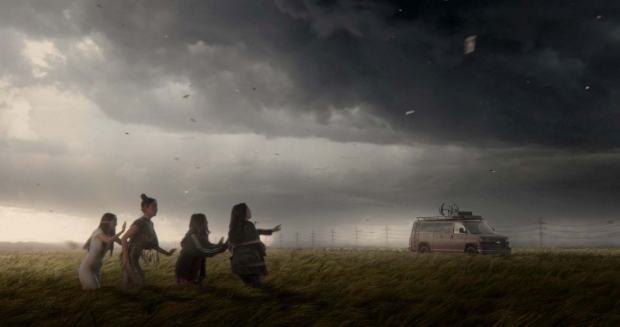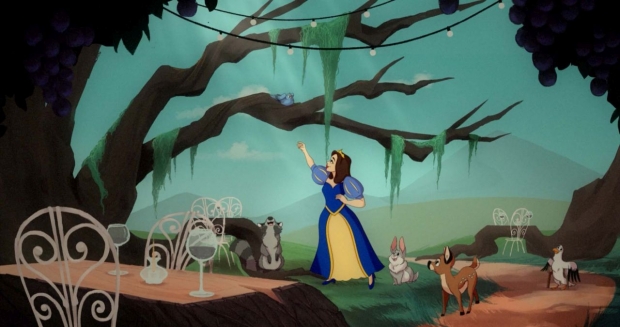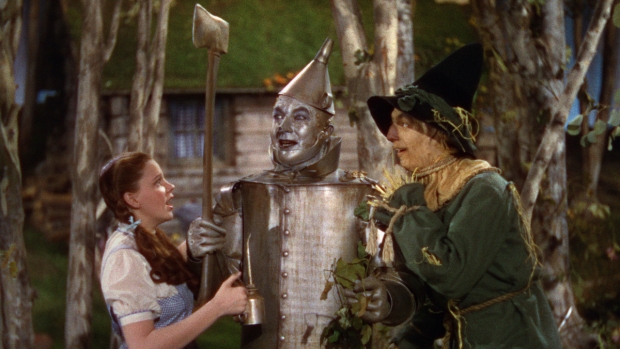





A minute and a half comedic parody of Disney animated fairy tales was done as cel-style animation. “The biggest challenge working in a cel-animated style is that, like building a house, it gets harder and costlier to change things once construction starts,” says Alex Popkin, director of motion design and animation at Ingenuity Studios. “This puts huge emphasis on the concept phase – from character design approvals to the creation of an animatic. The animatic represents our blueprint, where we get to try and audition things, and if the jokes and visual beats work there, they’ll only look better once we start animating.”

In the series, an imaginary feline has a funny habit of interacting with human cast members. “For the Cat Lady, we wanted to push her character a little further this season, while also walking a fine line of still grounding it in reality,” remarks Lebensfeld. “We still needed to inject a lot of character that Beth Grant brought to the table. It was all about finding that delicate balance.” A tornado scene inspired by the blockbuster Twister symbolizes the spiralling anxiety experienced by a character. “We have done tornado work in the past, so we already had the methodology,” Lebensfeld reveals. “The biggest challenge was time constraints.”
Trevor Hogg is a freelance video editor and writer best known for composing in-depth filmmaker and movie profiles for VFX Voice, Animation Magazine, and British Cinematographer.
The Ingenuity Studios team had fun creating the cel-animation parody. “We knew the client was really enamored with the vibe and look of the 2007 film Enchanted with Amy Adams, so that was definitely in our minds from the start,” reveals Popkin. “Because Enchanted itself was a parody of the 1990s Disney ‘renaissance’ era of animation, we did our best to study and take inspiration from backgrounds and performances in Beauty and the Beast and The Little Mermaid. The seductively evil ‘Allisons,’ as an example, were specifically inspired by Ursula’s creepy hench-eels Flotsam and Jetsam.”

Post-production lasted for nine months, with character development for 2D animated content taking the most amount of time. One major creative challenge was the virtual Greece location in the garage. “It was a very high-concept thing,” notes Lebensfeld. “We worked closely with Michelle, Jordan, and Chad to find just the right look. The virtual experience that Jules goes on was loosely inspired by artist James Turrell.”
[embedded content]
“There were lots of set extensions, a decent amount of greenscreen work, and we were also on location all over Los Angeles,” Lebensfeld concludes. “Even when we were on location, we needed set extensions. The castle scene is a good example of that. We had a high shot count on a TV schedule and we’re always up for that challenge.”
Part of the visual research involved studying Disney animated features from the early 1990s. “Disney had a specific way of multi-planing their gorgeous hand-painted backgrounds to show realistic parallax,” explains Popkin. “There are subtle 1990s Disney homages throughout. For our spinning transition from the woods to the boutique hotel, we looked at a climactic scene in The Lion King where they executed a faux ‘360 degree’ spin move using only 2D layers. As an animation lover, it was satisfying to parse and honor those techniques in small ways that served the visuals. The mansion in the hills of Malibu was particularly fun to do concept work on because we were forced to figure out how to mix luxurious modern and medieval aesthetics, which sit on completely opposite ends of the design spectrum. Modernism eventually won out, and the overall direction we settled on was akin to having the characters ‘cosplaying’ in fairy-tale garb in a mostly modern world, with fun small details like our ‘carriage-Porsche,’ the funniest representations of that odd-design mixture.”
The heaviest simulations where for the cat hair and tornado. “We have a good creature simulation process, so we were never waiting on simulations,” Lebensfeld says. Noting digital doubles were regularly created for face and limb replacements, he adds, “There’s an episode that takes place at an outdoor music festival and we were able to use our crowd system that is populated with digital doubles to fill out the venue when we only had a handful of extras.”
When a long-term relationship comes to an end for Jules (Kat Dennings), emotional insecurities fuel her wild imagination as she attempts to navigate single life once again, in the Hulu comedy series Dollface. The show, created by Jordan Weiss, also stars Brenda Song, Shay Mitchell, and Esther Povitsky. Michelle Nader serves as EP and showrunner. For Season 2, VFX supervisor Chad Wanstreet collaborated with sole vendor Ingenuity Studios to produce 494 shots across 10 episodes. “What was interesting about Dollface is that it required a large variety of skills and requests of our team,” says David Lebensfeld, founder and VFX supervisor at Ingenuity Studios. “We were doing 3D photoreal character animation while also doing 2D cel-style animation and real-time LED stagework. Our studio is uniquely suited to handle all of this by design.” Noting Wanstreet is a frequent collaborator, Lebensfeld adds, “Chad has always been excellent at communicating his vision. In fact, I’d say we have a shorthand with him which is a real value to our work together.”
Before reading about the studio’s work on the series, take a look at their VFX breakdown reel!

Visual effects shot production was shared between facilities in Los Angeles and Vancouver. “Being the sole vendor absolutely streamlined the post-production process,” Lebensfeld explains. “We were able to shuffle our artist teams from episode to episode quickly and efficiently. Our artists are multi-disciplined so we can lean on them to get a wide variety of work done in an efficient manner.” The remote workflow has become more routine because of the pandemic. He continues, “The impact of the pandemic is not exclusive to this project. It’s a benefit in a sense that we’re able to leverage global talent, and access artists that were previously not accessible. That was particularly the case with 2D cel animators.”







